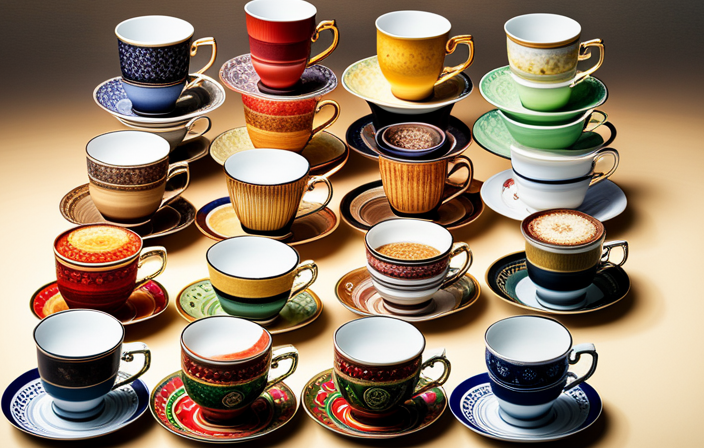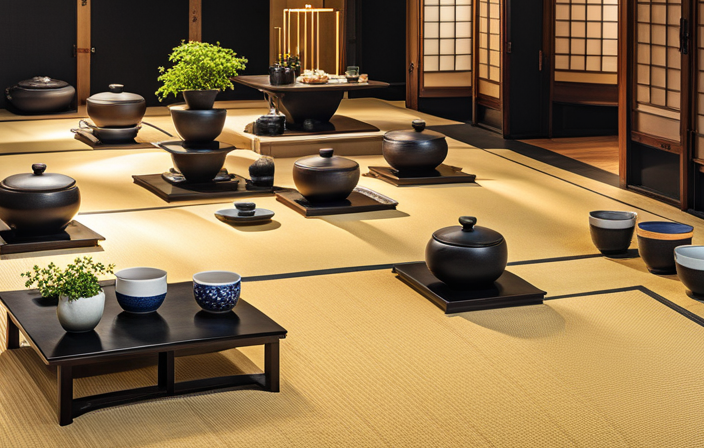As a tea enthusiast, I’ve always believed that a cup of tea can transport you to different corners of the world. In fact, it’s like discovering the world in a cup!
If you’re eager to embark on a flavorful journey, I’ve got just the thing for you: 8 different types of tea that you absolutely must try. From the boldness of black tea to the tranquility of herbal tea, each sip will awaken your senses and leave you craving for more.
So, grab your favorite mug and let’s explore the wonders of tea together!
Key Takeaways
- Black tea and green tea are rich in antioxidants and provide a comforting boost.
- White tea has a delicate flavor and numerous health benefits, including support for weight loss and heart health.
- Oolong tea offers a unique and delightful flavor experience with diverse flavor profiles.
- Herbal teas, such as lavender, chamomile, ginger, and turmeric, have various health benefits and cater to different tastes.
Black Tea
I love starting my day with a cup of black tea. Not only does it provide a comforting and invigorating boost, but it also offers numerous health benefits.
Black tea is rich in antioxidants, which help protect the body against free radicals and reduce the risk of chronic diseases. It also contains caffeine, which can improve alertness and focus.
To fully enjoy the benefits of black tea, it’s important to know the proper brewing techniques. Start by boiling water and steeping the tea leaves for 3-5 minutes. This allows the flavors to fully develop without becoming bitter. Adding a splash of milk or a squeeze of lemon can enhance the taste.
Green Tea
Green tea is a type of tea that’s known for its many health benefits. It’s rich in antioxidants and has been linked to a lower risk of heart disease and cancer.
Green tea comes in a variety of flavors, such as matcha, jasmine, and sencha, making it a popular choice among tea enthusiasts.
Health Benefits of Green Tea
Drinking a cup of green tea every day can provide numerous health benefits. Green tea has been known to aid in weight loss due to its ability to boost metabolism and increase fat oxidation. It’s also rich in antioxidants, such as catechins, which help to reduce inflammation and protect against chronic diseases.
These antioxidants can also improve brain function and promote healthy skin. Green tea is a great alternative to sugary beverages and can be enjoyed hot or cold. It has a refreshing and slightly bitter taste, with a subtle grassy aroma.
Green tea is available in a variety of flavors, including jasmine, mint, and lemon. These flavors add a delightful twist to the traditional green tea, making it even more enjoyable to consume.
Popular Green Tea Flavors
During my recent trip to Japan, I discovered the delightful flavors of green tea, including matcha, genmaicha, and hojicha. Green tea is known for its numerous health benefits, but its unique flavors make it even more enticing.
Matcha, a finely ground powder made from shade-grown tea leaves, has a vibrant green color and a rich, umami taste.
Genmaicha, also known as ‘popcorn tea,’ is a blend of green tea and roasted brown rice, giving it a nutty and toasty flavor.
Hojicha, on the other hand, is made from roasted green tea leaves, resulting in a smooth and slightly smoky taste.
When it comes to flavored green tea, there are several brands that stand out. Some of the best green tea brands for flavored options include Harney & Sons, The Republic of Tea, and Celestial Seasonings. These brands offer a wide range of flavors, from fruity blends to floral infusions, providing a delightful experience for tea lovers.
Oolong Tea
I’ve tried a few cups of oolong tea, and I must say, it has such a unique and delightful flavor. Oolong tea, also known as ‘black dragon tea,’ originates from China and Taiwan. Its flavor profiles can vary greatly depending on the region it comes from and the processing techniques used.
Here are five flavor profiles you might encounter when exploring oolong tea:
- Floral: Oolong teas with floral notes, such as jasmine or orchid, offer a delicate and aromatic experience.
- Fruity: Some oolong teas have fruity undertones, like peach or plum, providing a sweet and refreshing taste.
- Roasted: Oolong teas that have been roasted have a warm and toasty flavor, reminiscent of nuts or caramel.
- Creamy: Certain oolong teas possess a creamy texture and taste, similar to milk or butter.
- Earthy: Oolong teas with earthy notes offer a grounding and robust flavor, often described as woody or mossy.
Exploring these diverse flavor profiles of oolong tea is like embarking on a journey that takes you to different parts of the world, with each cup offering a unique and delightful experience. So why not sit back, relax, and savor the flavors of oolong tea?
White Tea
I love starting my day with a cup of white tea. Not only does it have a delicate and refreshing flavor, but it also offers numerous health benefits.
From boosting the immune system to promoting healthy skin, white tea is packed with antioxidants and nutrients.
When brewing white tea, it’s important to use water that isn’t too hot to preserve its delicate flavors. Some popular white tea blends include jasmine white tea and silver needle white tea.
Health Benefits of White Tea
White tea offers numerous health benefits, including boosting the immune system and reducing the risk of chronic diseases. It’s a type of tea that’s minimally processed, allowing it to retain its high levels of antioxidants and nutrients. Here are some of the health benefits of white tea:
-
Weight Loss: White tea can aid in weight loss by boosting metabolism and promoting fat burning. It can also help to suppress appetite, making it a great addition to a healthy diet and exercise routine.
-
Skin Health: The antioxidants present in white tea can help protect the skin from damage caused by free radicals, reducing the signs of aging and promoting a healthy complexion.
-
Heart Health: White tea has been shown to improve heart health by reducing cholesterol levels and lowering blood pressure.
-
Cancer Prevention: The antioxidants in white tea have been found to have anti-cancer properties, helping to prevent the growth of cancer cells.
-
Bone Health: White tea contains compounds that can strengthen bones and help prevent conditions like osteoporosis.
Incorporating white tea into your daily routine can be a simple and effective way to support your overall health and well-being.
Brewing Techniques for White Tea
Brewing techniques for white tea can greatly impact the flavor and aroma of the final cup. To ensure a perfect brew every time, here are some tea brewing tips to follow. First, use fresh, filtered water to bring out the delicate flavors of white tea. Boil the water and let it cool for a minute before pouring it over the tea leaves. Steep the tea for about 3-5 minutes, depending on your preference for strength. Remember, over-steeping can result in a bitter taste. When it comes to choosing the best white tea brands, consider popular options like Bai Hao Yin Zhen (Silver Needle) and Bai Mu Dan (White Peony). These brands are known for their high-quality leaves and exquisite taste. So, grab your favorite white tea, follow these brewing techniques, and savor the delightful flavors that await you.
| Tea Brewing Tips | Best White Tea Brands |
|---|---|
| Use fresh, filtered water | Bai Hao Yin Zhen (Silver Needle) |
| Let water cool for a minute | Bai Mu Dan (White Peony) |
| Steep for 3-5 minutes |
Popular White Tea Blends
When it comes to popular white tea blends, my personal favorite is the combination of white tea with jasmine flowers, creating a delicate and aromatic infusion. This blend seamlessly combines the subtle sweetness of white tea with the fragrant floral notes of jasmine. It’s a perfect choice for those looking for a light and refreshing tea experience.
In addition to the white tea and jasmine blend, there are several other popular white tea blends that are worth exploring. These include:
-
White tea with peach: This blend offers a harmonious combination of the mellow white tea and the juicy sweetness of ripe peaches.
-
White tea with lavender: The soothing aroma of lavender complements the gentle flavors of white tea, creating a calming and relaxing blend.
-
White tea with berries: The tartness of berries adds a vibrant twist to the delicate flavors of white tea, resulting in a refreshing and fruity infusion.
-
White tea with mint: The cooling and refreshing qualities of mint perfectly complement the subtle flavors of white tea, creating a revitalizing blend.
-
White tea with rose petals: The floral notes of rose petals enhance the delicate flavors of white tea, creating a romantic and fragrant infusion.
As for popular white tea brands, some well-known names in the industry include Teavana, Harney & Sons, and Republic of Tea. These brands offer a wide range of white tea blends, each with its own unique characteristics and flavor profiles.
The history of white tea can be traced back to ancient China, where it was said to be reserved for royalty and nobility. It was traditionally plucked from a specific variety of tea plant, known as the ‘Da Bai’ or ‘Big White’ tea tree, and it was processed using minimal oxidation and handling to preserve its delicate flavors and appearance.
Herbal Tea
I love sipping on herbal tea in the evenings, especially during the colder months. Herbal tea is a delightful and comforting beverage that offers a range of different blends and health benefits. From soothing chamomile to invigorating peppermint, there’s a herbal tea out there for everyone.
One popular blend is lavender and chamomile tea, known for its calming properties and ability to promote relaxation and better sleep. Another blend, ginger and turmeric tea, has anti-inflammatory properties and can help with digestion and boosting the immune system.
Herbal teas are also known for their antioxidant content, which can help protect against cell damage and reduce the risk of chronic diseases. For example, green tea is rich in antioxidants called catechins, which have been linked to a lower risk of heart disease and certain types of cancer.
Rooibos Tea
One of my favorite ways to relax is by sipping on a cup of rooibos tea.
Rooibos tea, also known as red bush tea, is a caffeine-free herbal tea that originates from South Africa.
It offers a range of benefits, including being rich in antioxidants, promoting digestion, and supporting a healthy immune system.
The flavors of rooibos tea can vary, from a naturally sweet and nutty taste to fruity and floral undertones. Some popular flavors include vanilla, honeybush, and citrus.
With its soothing aroma and smooth taste, rooibos tea is a perfect companion for a cozy evening or a refreshing break during the day.
Now, let’s move on to another delightful tea option: matcha tea.
Matcha Tea
I love savoring the earthy flavor and vibrant green color of matcha tea during my morning meditation. Matcha, a powdered form of green tea, has gained popularity worldwide due to its unique taste and numerous health benefits. Unlike regular green tea, matcha is made from shade-grown tea leaves, which are then ground into a fine powder. This process preserves the tea’s vibrant green color and concentrates its flavor.
Matcha is rich in antioxidants, which help boost the immune system and promote overall well-being. It also contains a small amount of caffeine, providing a gentle energy boost without the jitters. Matcha can be enjoyed on its own or used as an ingredient in various recipes, such as matcha lattes, smoothies, and desserts. While both matcha and green tea come from the same plant, matcha is more potent in flavor and health benefits due to its unique preparation method.
Now, let’s delve into the world of chai tea.
Chai Tea
Chai tea is a delicious blend of black tea, spices, and milk that creates a cozy and indulgent beverage. It’s a popular choice for tea enthusiasts and those looking for a comforting drink.
Here are some reasons why chai tea is worth trying:
-
Variety of flavors: Chai tea recipes can vary, but they often include spices like cinnamon, cardamom, ginger, and cloves, which give the tea a warm and aromatic taste.
-
Health benefits: Chai tea isn’t only a tasty beverage but also offers health benefits. The spices used in chai tea, such as ginger and cinnamon, are known for their anti-inflammatory and antioxidant properties.
-
Boosts digestion: Chai tea can aid in digestion due to the presence of ginger and cardamom, which have been traditionally used to soothe the stomach and relieve digestive issues.
-
Provides energy: Chai tea contains caffeine from black tea, which can give you a natural energy boost without the jitters.
-
Promotes relaxation: Chai tea is often enjoyed in a calm and cozy environment, making it the perfect drink to unwind and relax after a long day.
Frequently Asked Questions
How Is Black Tea Different From Green Tea?
Black tea and green tea are two distinct types of tea. Black tea is fully fermented while green tea is unfermented. The main difference lies in their flavor and color.
Black tea has a stronger, bolder flavor with a deep amber color, while green tea has a more delicate, grassy flavor and a light green color.
Additionally, black tea contains health benefits such as improved heart health, while green tea is rich in antioxidants that help protect against chronic diseases.
Can Herbal Tea Be Consumed by Pregnant Women?
Herbal tea during pregnancy is a topic that concerns many expecting women. It’s important to understand the potential effects on fetal development.
While herbal teas can have various health benefits, not all are safe to consume during pregnancy. Some herbs may cause uterine contractions or have other negative effects.
It’s best to consult with a healthcare provider before consuming any herbal tea during pregnancy to ensure the safety of both the mother and the baby.
What Is the Caffeine Content in Matcha Tea Compared to Other Types of Tea?
Matcha tea has a higher caffeine content compared to other types of tea, but it’s still lower than that of coffee. The effects of caffeine in matcha tea on the body can vary depending on the individual.
It can provide a gentle, sustained energy boost without the jitters or crash associated with coffee. Some people find it helps with focus and concentration. However, it’s important to consume matcha tea in moderation to avoid excessive caffeine intake.
Are There Any Health Benefits Associated With Drinking Chai Tea?
There are indeed several health benefits associated with drinking chai tea.
Chai tea is made from a combination of black tea, spices, and milk, which can provide a variety of health benefits.
The spices used in chai tea, such as cinnamon, ginger, and cardamom, have anti-inflammatory properties that can help boost the immune system and aid digestion.
Additionally, black tea contains antioxidants that can promote heart health.
If you’re interested in making homemade chai tea, there are many recipes available online that can guide you through the process.
How Is Rooibos Tea Prepared and Served?
Rooibos tea is a delicious and healthy beverage that offers numerous benefits. When preparing this tea, start by boiling water and adding the rooibos tea leaves. Let it steep for about 5-7 minutes to release its rich flavors.
You can enhance the taste by adding honey or a slice of lemon. Rooibos tea can be enjoyed both hot and cold, making it a versatile and refreshing choice for any time of the day.
Conclusion
In conclusion, exploring the world of tea is like embarking on a flavorful journey around the globe.
From the boldness of black tea to the delicate notes of white tea, each variety offers a unique experience for the senses.
So don’t be afraid to step out of your comfort zone and try something new.
As the saying goes, ‘Don’t judge a book by its cover’ – you might just discover your new favorite cup of tea.
Cheers to tea adventures!










